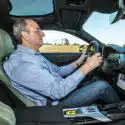Best of its time – and of all time? Perhaps…
One truncated and tragic season, that was all. But the 300 SLR can never be forgotten

In the 1955 Dundrod TT, Moss and John Fitch led a Mercedes-Benz 1-2-3
Mercedes-Benz AG
Its racing life was so short, and yet is the Mercedes-Benz 300 SLR the greatest competition sports car of them all? There’s a case to be made.
Its stunningly elegant form, its levels of superiority and domination, the twin maestros most associated with it who twirled its wheel so majestically… and the heady mix of triumph and devastating tragedy it represents: quite a cocktail, all told. Had the 300 SLR raced beyond the turbulence of that 1955 season, sports car racing history, and specifically that of the Le Mans 24 Hours, would surely read oh so differently.
Even at the time, those lucky enough to encounter it knew this was special. “The various manifold tubes, fuel injection components and centre-mounted brake drums comprised a complex array of sophisticated mechanical exotica the likes of which could be found on no other automobile of the time,” raved American works driver John Fitch. “A platoon of crack technicians was required to prepare these cars to race, but once running properly, they seemed capable of going on forever.”
Skip back through its race history – the story is more dramatic than any movie. Born from the W196 grand prix car, the two-seat 300 SLR was created solely for one reason: to enable Mercedes-Benz to complete a clean sweep of both F1 and sports car world championships – and naturally, the company threw everything at the cause.

For Motor Sport magazine, No722 will forever be our most-cherished car
Unveiled after the grand prix team’s successful sojourn to Argentina, its first three months were dedicated to achieving that landmark of beating the Italians on their own patch at the Mille Miglia. You know how it went.
And then what happened at Le Mans, after domination at the Nürburgring’s Eifelrennen. When the two remaining cars were withdrawn seven and a half hours after poor ‘Levegh’ had flown into the crowd, Moss and Fangio were two laps clear. But with 83 spectators slain, who cares?
Understandably, the rest of its racing life tends to be overlooked – but the shock and awe rolled on. Under growing talk of an end-of-season withdrawal, there was the August race in Kristianstad, Sweden, arranged in part to opportunistically (and coldly) fill the void created by the cancellations of such as the German GP and Nürburgring 1000Kms. Fangio and Moss lapped the field. Then there was Dundrod and the 50th anniversary Tourist Trophy.
The TT was run as a scratch rather than handicapper, on narrow country roads in rural Northern Ireland, at speeds approaching 150mph. What, in the wake of events in June? These were less sensitive times. But imagine had a 300 SLR been involved in the dreadful crash that claimed three lives. Moss pressed on regardless, with Fitch playing a bit-part in a gritted-teeth victory that lifted Mercedes-Benz within range of its world championship grail.
How it was won on the Targa Florio is almost equal to the better known Mille Miglia yarn. The intensity of Moss’s record first lap. How he then crashed into a field and required (illegal) help from Sicilian locals to find his way back out. Then a guesting Peter Collins making up 9min and surviving his own smash through a stone wall to hand Moss back his lead. “I shouted, ‘Is it still running OK?’” wrote Alfred Neubauer in Speed was my Life. “Moss nodded, he climbed out of the cockpit, staggered into the pit and sank down exhausted on a box in the corner. I said to Peter, ‘Off you go, see if you can pull the chestnuts from the fire.’”
The night before, Neubauer had felt the bottom drop from his world when the letter arrived: he already knew the F1 programme was over, but sports cars too? Over 13 laps of the 44-mile Madonie, the mission was accomplished, even if the 300 SLR’s elegant lines took one hell of a hammering. It would remain unbeaten (Le Mans withdrawal included) forever after. But there could have been so much more. DS
Where are they now?
0001/54
(note earlier year) Development car, 2nd Eifelrennen (Moss)
Owned by Mercedes-Benz
0002/55
T-car, unraced
Owned by Mercedes-Benz
0003/55
2nd Mille Miglia, 1st Eifelrennen, 1st Kristianstad (all Fangio)
Owned by Mercedes-Benz
0004/55
1st Mille Miglia (Moss/Jenkinson), 4th Eifelrennen (Kling), withdrawn Le Mans (Kling & Simon), 2nd Kristianstad (Moss), 1st TT (Moss/Fitch), 1st Targa Florio (Moss/Collins)
Owned by Mercedes-Benz
0005/55
DNF Mille Miglia (Kling), 2nd TT (Fangio/Kling), 4th Targa Florio (Fitch/Titterington)
French National Motor Museum
0006/55
DNF Mille Miglia (Herrmann), DNF Le Mans (Fitch/Levegh)
Destroyed
0007/55
Coupé, unraced
Owned by Mercedes-Benz
0008/55
Coupé, unraced
Sold 2022 to private collector
0009/55
Never assembled
0010/55
1956 car, unraced
Owned by Mercedes-Benz

